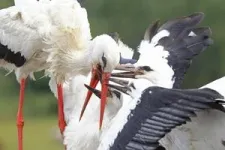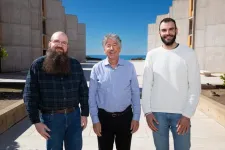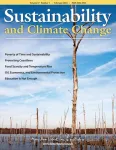(Press-News.org) THIS RELEASE IS EMBARGOED UNTIL MARCH 4, 2024, at 3:00 PM U.S. EASTERN TIME.
Research led by scientists from University of Wyoming and Max Planck Institute of Animal Behavior shows that migrating animals refine their behavior as they get older, suggesting that experiential learning is an important part of successful migration.
While genetics and social behavior are important factors shaping animal migrations, information gained through individual experience also appears to help shape migratory movements, says a research team led by Ellen Aikens. Aikens, who has a joint faculty appointment with UW’s Haub School of Environment and Natural Resources, was among the first cohort of assistant professors hired in 2023 by UW’s new School of Computing. Aikens’ research at the intersection of animal behavior and data science is driven by new possibilities from advanced computing and data science.
The migration findings appear March 4 in Proceedings of the National Academy of Sciences, one of the world’s most prestigious multidisciplinary scientific journals covering the biological, physical and social sciences.
The study, which also involved researchers from the University of Konstanz, involved technically sophisticated tracking of over 250 white storks spread across five breeding areas in southern Germany and Austria between 2013 and 2020.
The tracking data collected by the researchers not only pinpointed the migration pathways of the storks, but it also measured the timing and pace of individual storks as well as estimating the amount of energy storks used while flying. The team found that while young storks took their time exploring new places during migration, their migrations become faster as they age.
“As the birds age and gain more experience, older individuals stop exploring new places and instead move more quickly and directly, resulting in greater energy expenditure during migratory flight,” wrote lead author Aikens, whose research in recent years has provided insights into the movement of big-game animals in western Wyoming. “During spring migration, individuals innovated novel shortcuts during the transition from early life into adulthood, suggesting a reliance on spatial memory acquired through learning.”
Individual storks incrementally straightened their migration routes to find more direct ways to move between destinations during the spring migration to summer breeding and nesting grounds, the researchers say. The findings could have implications for a variety of other species of migrating animals.
“Although information has largely been overlooked as a currency shaping migratory behavior, gaining information and using it to incrementally refine migration behavior through learning could play an important role in saving both energy and time,” the researchers wrote. “The landscapes that animals move through are complex and dynamic, requiring that migrants learn where and when favorable conditions that facilitate movement occur and how to exploit them efficiently.”
The researchers don’t discount the importance of genetics and “culturally inherited information” in animal migrations, but they say the new findings point to individual experience as another key factor.
“Whether the first migration is guided by genetics or results from following informed individuals, learning within a lifetime represents an additional and complementary mechanism shaping animal migration,” the paper says.
END
New research shows migrating animals learn by experience
2024-03-04
ELSE PRESS RELEASES FROM THIS DATE:
Modeling the origins of life: New evidence for an “RNA World”
2024-03-04
LA JOLLA (March 4, 2024)—Charles Darwin described evolution as "descent with modification." Genetic information in the form of DNA sequences is copied and passed down from one generation to the next. But this process must also be somewhat flexible, allowing slight variations of genes to arise over time and introduce new traits into the population.
But how did all of this begin? In the origins of life, long before cells and proteins and DNA, could a similar sort of evolution have taken place on a simpler scale? ...
Scientists put forth a smarter way to protect a smarter grid
2024-03-04
RICHLAND, Wash.—There’s a down side to “smart” devices: They can be hacked.
That makes the electric grid, increasingly chock full of devices that interact with one another and make critical decisions, vulnerable to bad actors who might try to turn off the power, damage the system or worse.
But smart devices are a big part of our future as the world moves more toward renewable energy and the many new devices to manage it. Already, such tools play a big role in keeping the power humming. The portion of the grid owned by ...
An evolutionary mystery 125 million years in the making
2024-03-04
Plant genomics has come a long way since Cold Spring Harbor Laboratory (CSHL) helped sequence the first plant genome. But engineering the perfect crop is still, in many ways, a game of chance. Making the same DNA mutation in two different plants doesn’t always give us the crop traits we want. The question is why not? CSHL plant biologists just dug up a reason.
CSHL Professor and HHMI Investigator Zachary Lippman and his team discovered that tomato and Arabidopsis thaliana plants can use very different regulatory systems to control the same exact ...
Data science approach to identifying thermal conductivity-related structural factors in amorphous materials
2024-03-04
1. Using data science techniques, a NIMS–Tohoku University research team has discovered that different thermal conductivities exhibited by an amorphous material with the same composition are attributable to the sizes of atomic rings in its atomic structure. This is one of the first studies demonstrating that the structural features of amorphous materials can be correlated with their physical properties.
2. It is already feasible to synthesize amorphous materials with the same compositions but different thermal conductivities. However, the structural factors responsible for differences in thermal conductivity had yet to be identified due to a lack of appropriate analytical ...
Deciphering the male breast cancer genome
2024-03-04
Male breast cancer has distinct alterations in the tumor genome that may suggest potential treatment targets, according to a study by Weill Cornell Medicine investigators. They have conducted the first whole genome sequencing analysis of male breast cancer, which looked at the complete DNA landscape of tumor samples from 10 patients.
This is an important step in viewing breast cancer in men, which represents less than 1 percent of all breast cancer cases each year, as a unique disease. Though most research has focused on women with breast cancer, the incidence in men has increased at a much faster rate than in women over the last 40 years. Also, ...
Detection of suicide-related emergencies among children using real-world clinical data: A free webinar from the Brain & Behavior Research Foundation
2024-03-04
According to the CDC, the suicide rate among young people ages 10‒24 increased 62% from 2007 through 2021. The CDC’s Youth Risk Behavior Summary reports that in 2021, 22% of high school students seriously considered attempting suicide during the year and 18% made a suicide plan. These statistics indicate a mental health crisis facing our youth. How can we identify children in crisis? Who is being missed?
The Brain & Behavior Research Foundation (BBRF) is hosting a free webinar, “Detection of Suicide-Related Emergencies Among ...
Editor-in-Chief of Sustainability and Climate Change Madhavi Venkatesan named USA TODAY Woman of the Year for Massachusetts for leading plastic bottle ban efforts
2024-03-04
Madhavi Venkatesan, PhD, Editor-in-Chief of the peer-reviewed journal Sustainability and Climate Change and founder of Sustainable Practices, has been named USA TODAY Woman of the Year for the state of Massachusetts in recognition of her outstanding efforts to eliminate single-use plastic bottles across Cape Cod and the Islands.
With economics and sustainability at the forefront, Venkatesan established Sustainable Practices in 2016, aiming to address pressing environmental issues through innovative solutions. Since then, she and her nonprofit team have spearheaded ...
Tests show high-temperature superconducting magnets are ready for fusion
2024-03-04
In the predawn hours of Sept. 5, 2021, engineers achieved a major milestone in the labs of MIT’s Plasma Science and Fusion Center (PSFC), when a new type of magnet, made from high-temperature superconducting material, achieved a world-record magnetic field strength of 20 tesla for a large-scale magnet. That’s the intensity needed to build a fusion power plant that is expected to produce a net output of power and potentially usher in an era of virtually limitless power production.
The test was immediately declared ...
Zika vaccine safe, effective when administered during pregnancy
2024-03-04
A vaccine against Zika virus is safe and effective when administered both before and during pregnancy, according to new research published in npj Vaccines.
The purified, inactivated Zika vaccine (ZPIV) candidate, developed by Walter Reed Army Institute of Research (WRAIR), is being evaluated in animal models at Texas Biomedical Research Institute (Texas Biomed) in collaboration with WRAIR and Trudeau Institute in New York.
The vaccine candidate has previously been shown to effectively block prenatal Zika virus transmission when given to nonhuman primates ...
Firearm ownership is correlated with elevated lead levels in children, study finds
2024-03-04
PROVIDENCE, R.I. [Brown University] — Childhood lead exposure, primarily from paint and water, is a significant health concern in the United States, but a new study has identified a surprising additional source of lead exposure that may disproportionately harm children: firearms.
A team led by researchers at Brown University found an association between household firearm ownership and elevated lead levels in children’s blood in 44 states, even when controlling for other major lead exposure ...









